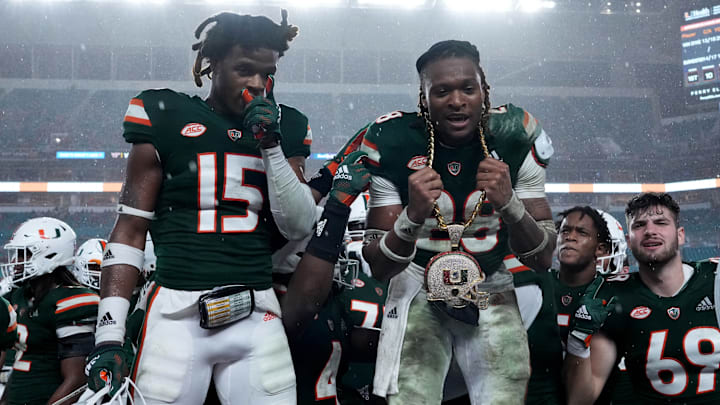Miami is back at No. 2 (after a brief omission in Week 6), and that number means something different than it did eight years ago. In 2017, Mark Richt's Hurricanes hit second in the AP poll after the 41–8 demolition of Notre Dame, fueled by the swagger of the Turnover Chain and an opportunistic defense. In 2025, Mario Cristobal's group climbed to No. 2 on the strength of wins over Notre Dame and USF. They were then jumped by Oregon who defeated Penn State, but a dominant road win at Florida State and a veteran quarterback who is making all the right throws got them back at No. 2. Let's take a trip down memory lane and see how Miami got to this point, as well as how the two teams compare.
On Nov. 11, 2017, Miami forced four turnovers and bullied No. 3 Notre Dame at Hard Rock, a night that became a national TV infomercial for Manny Diaz's defense and the culture that came with it. That Sunday, Miami moved to No. 2. As we all know, the season ended poorly: losses to Pitt (24–14) on Black Friday, then to Clemson in the ACC title game (38–3), and to Wisconsin in the Orange Bowl (34–24), closing 10–3 and No. 13 in the final AP poll.
Fast forward to this October. The AP pushed Miami to No. 2 after a 28–22 win at then–No. 18 Florida State in Tallahassee. Carson Beck went 20-of-27 for 241 yards and four touchdowns without a pick, Miami finished plus-3 in turnovers, and the offensive line gave up only one sack. The committee doesn't meet until November, but voters gave credit right away.
The 2017 and 2025 teams share strong defenses but express it differently. The 2017 defense lived on creating havoc and forcing turnovers. Miami finished with 31 takeaways and built an identity around momentum swings. The Turnover Chain became a national talking point and Richt was still raving about it going into the following season. In Cristobal's program, the chain is gone — retired in 2022 — and the emphasis is on down-to-down discipline.
Quarterback comparison tells you even more about the eras. Malik Rosier was streaky but tough in 2017 (3,120 yards passing and 26 total TD's). He was a gamer who hit timely shots to Braxton Berrios and leaned on Travis Homer's run game. Beck arrived this year as a proven, high-efficiency operator from Georgia and, post-injury, chose Miami to run Shannon Dawson's attack. Through five games, he's completing north of 70% with double-digit touchdowns and only a handful of turnovers (something that was a major blemish for him in 2024).
It took a long, messy road to get back. After 2017, Miami spiraled through a half-decade of resets. There was the 35–3 thud against Wisconsin in the 2018 Pinstripe Bowl, the 2019 Independence Bowl shutout to Louisiana Tech, the 2020 Cheez-It Bowl loss after D'Eriq King's knee injury, and the 2021 Sun Bowl withdrawal amid COVID protocols. Manny Diaz was fired in December 2021; Miami hired Dan Radakovich as athletic director and Mario Cristobal as head coach the same week. Cristobal’s Year 1 was a 5–7 reboot. Year 2 climbed to 7–6 with a Pinstripe Bowl loss to Rutgers. Year 3 (2024) turned a corner at 10–3 and a Pop-Tarts Bowl instant classic. Year 4 is what you see now: 5–0 and sitting second in the country.
The 2017 ACC was still the classic footprint. In 2024–25, the league added Cal, SMU and Stanford, and Miami's schedule now stretches coast-to-coast. In the portal/collective era, Miami also rebuilt quickly at premium positions, most notably by landing Beck in January.
The lesson from 2017 is to finish through the tape. Those Canes fell apart as the year went on and other Miami teams have slowed down late in the season as well. Cristobal's team, by contrast, has been more efficient in the pass game and less dependent on turnover luck to score. If the balance that they have remains, Miami should finally be able to get over the late-season hump.
